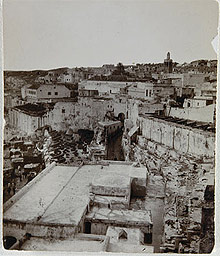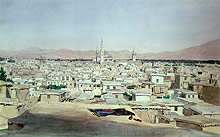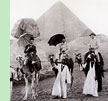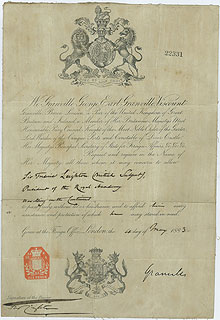Frederic Leighton's Travels
Where did he travel to?

A photograph of Tangiers, taken by Leighton during his visit of 1877. Courtesy of the Fogg Art Museum, Harvard University Art Museums, Friends of the Fogg Art Museum Fund
In 1868 he visited Egypt and was lent a steamboat by the Ottoman ruler of that country to explore the Nile. Queen Victoria's son Albert Edward (the future King Edward VII) had sent a letter to the Egyptian government requesting that Leighton be assisted during his stay in Cairo. This was the first of two visits by Leighton to Egypt. In 1873 he journeyed to Lebanon and Syria. In 1877 he was in Morocco. In 1893 he wrote to his sister Augusta stating 'I've had a tremendous tour through Germany - thirty towns in thirty days'. As Leighton got older he visited the remoter but yet geographically closer regions of Scotland and Ireland. In 1895, the year before his death, he paid his last visit to Algeria and the major cities of Italy.
How did he arrange his travel
As was the norm with wealthy society at the end of the nineteenth century, Leighton usually did his overseas travel from September onwards. Late spring and summer was a busy time in London and he would have been preparing for the summer exhibition at the Royal Academy of Arts. As with today, Leighton would have had access to travel literature, he mentions John Murray's (1808-92) guidebook in relation to sites in Spain. Descriptions of places from colleagues would also have been important. The pre-booking of accommodation was rare in the nineteenth century. Most travellers simply bargained for a good price with inn and hotel owners on arrival.Travel documentation and costs
Leighton's Coutts bank account records show that he paid the steamship company P&O Liners (Peninsular & Oriental Steam Navigation Company) £18.10 for his ticket to Egypt in 1868. This would amount to £1,106.00 in currency today. Passports were just as important in Leighton's time and in April 1895 he paid 13 shillings and 6 pence for a passport and visa (today £51.92) for his final trip to Algeria and Italy. While on holiday he could access his money from the relevant national banks of the country he was visiting. Therefore in 1867 there are withdrawals from the Imperial Ottoman Bank in Turkey for amounts of £50.00 (£3,000 today). In 1868 similar withdrawals are recorded from the Bank of Egypt.The practicalities of travel for Leighton
The first stage of Leighton's journey, depending on where he intended to go, was a carriage ride to one of London's train stations or port. Dover was the main port for trips to Paris and mainland Europe via Calais. Journeys to the Mediterannean and Middle East left from either London or Southampton, stopping at Lisbon, Gibraltar, Malta and finally Alexandria in Egypt. No mention is made in his letters of servants accompanying him on his trips to assist with luggage as was the norm in most households. It is probable that employees of carriage, rail and steamship companies carried out this work in the absence of personal servants. Although steamship had revolutionised sea travel making it quicker, more comfortable and not dependent on weather conditions, as had been the case with sailboats, Leighton still wrote in 1867 'I am a poor sailor at best'. Sea-sickness was obviously a problem for him as was health in general for nineteenth-century travellers. Writing to his father from Granada in October 1877 he explained 'I have been rather seedy (am all right now), not very, but enough to poison my pleasure; after two or three little amateur attempts (local apothecary, fellow-travellers, etc,) I thought it right (at Gibraltar) to see a doctor, not because I was ill but lest I should get worse and develop more serious symptoms, as internal disturbance occasionally does in hot countries. In a few days (and two large bottles of physic) I was much better, and am now, I repeat, quite 'myself' again'.Letters to his father in 1873 also gives insightful information on his eastern travels:
'three tedious days on board a Russian boat which tossed and rolled like a cork over a sea on which a P&O would have been motionless, brought me to Beyrout (Beirut), a cheery, picturesque, sunny port at the foot of Lebanon. Being in a hurry to get to the end of my journey, I did not stay more than half a day, but started by diligence for Damascus, a journey of some thirteen hours'.
'Dear Papa, I find that I am not as completely cut off from the western world here as I would have been led to believe I was, and that boats leave Damascus for Alexandria (in Egypt) weekly, and not fortnightly.'
In describing Damascus he writes - 'I can't hope to convey to you in writing any idea of this loveliness, and it is not within the scope of sketching, but I am having three or four photographs made. Lemon and myrtle trees rising tall and slim out of the marble floors and bending over tanks of running water, the unceasing song of the bubbling fountains'.
Leighton's reasons for travel

Max Schmidt Damascus 1844.
Private Collection
(© The Fine Art Society, London)
Private Collection
(© The Fine Art Society, London)

 Where did Leighton travel to?
Where did Leighton travel to?What was travelling like in the 19th century?
Who else was travelling between East and West and why?
 What did Leighton collect during his travels?
What did Leighton collect during his travels?How did museums collect in the 19th century?
What is Islamic Art?
 Who ruled the Middle East in Leighton's time?
Who ruled the Middle East in Leighton's time? How was life different from Victorian Britain?
How did these regions of the world interact?


